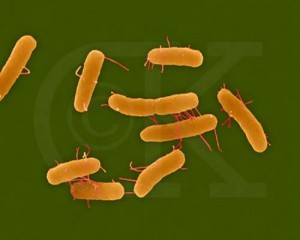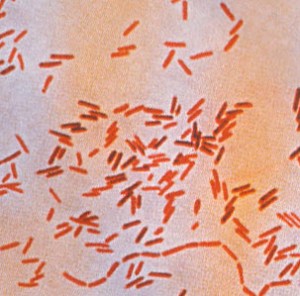Salmonellosis or Salmonella poisoning is one of the many food poisoning disorders caused by a bacterium that transmits mainly through raw meat, fish, poultry and seafood. Read on to find out about the causes, risk factors, symptoms and treatment options of this disease.
What is Salmonella Poisoning (Salmonellosis)?
Page Contents
- 1 What is Salmonella Poisoning (Salmonellosis)?
- 2 Salmonellosis Incidence
- 3 Salmonella Poisoning Causes
- 4 Salmonellosis Risk Factors
- 5 Salmonellosis Pathogenesis
- 6 Signs and Symptoms of Salmonella Poisoning
- 7 Salmonellosis Diagnosis
- 8 Salmonella Poisoning Differential Diagnosis
- 9 Salmonellosis Treatment
- 10 Salmonella Poisoning Home Remedies
- 11 Salmonellosis Complications
- 12 Salmonella Poisoning Prognosis
- 13 Salmonellosis Prevention
It is a contagious food-borne bacterial infection affecting the intestinal tract of its patients. It is caused by a bacterium known as Salmonella, which lives in the intestines of the humans and other animals. It is shed through feces.
Humans are most frequently affected by the disease through contaminated food or water sources.
Salmonellosis Incidence
Approximately 142,000 people are infected by these bacteria in the United States every year. The bacteria are usually transmitted from chicken eggs. Around 30 out of all infected individuals die due to the disease.
Salmonella Poisoning Causes
The Salmonella bacteria living within the intestines of humans, animals and birds can contaminate foods and water through feces. In majority of the cases, people develop the infection by ingesting contaminated foods. The foods that are infected most commonly include:
Picture 1 – Salmonellosis
Raw meat, seafood and poultry
Feces containing the bacteria can come into contact with raw poultry (chicken, eggs etc) and meat during butchering process. The seafood contamination may occur due to harvesting from infected water. Eating undercooked meat like pork, beef as well as raw or undercooked poultry and seafood is one of the main causes of salmonella infection.
Raw Eggs
It is the shell that generally protects an egg from any bacterial infection. Sometimes however, an infected chicken can produce eggs containing salmonella before the formation of the shell. Consuming raw eggs dipped in homemade hollandaise sauce and mayonnaise can lead to the condition.
Fruits and Vegetables
Fresh fruits and vegetables, especially the imported varieties, can get contaminated if washed with infected water. The contamination can also occur if raw foods like salads get in contact with infected meat.
Foods can also get infected if prepared or handled without washing the hands properly after changing diapers or using the toilet. Pets, especially reptiles and birds may be contaminated by the Salmonella bacteria which can cause the infection if one does not wash the hands properly after handling pets.
Sometimes, individuals infected by salmonella may continue to carry and excrete the bacteria for more than a year after being completely cured. In some rare cases, certain patients only carry and pass the infection without developing any symptoms themselves.
Salmonellosis Risk Factors
There are a number of risk factors for this type of food poisoning. The main factors that considerably increase the risk of development of this disease include:
- Travelling to developing countries where the infection is more prevalent due to poor sanitation
- Having pets like reptiles and birds which increase the risk of the disease to the owners
- Living in places like hostels or hospitals where proper hygiene is difficult to be maintained while living with a large group of people
- Using high amounts of antacids, which can stimulate the growth of these bacteria by reducing the stomach acid amounts
- Inflammatory bowel disorders that destroy the intestine lining and can make it easier for the salmonella bacteria to grow
- Disorders like AIDS, Sickle cell disease and Malaria which may hamper the functioning of the immune system
Salmonellosis Pathogenesis
The disorder occurs only when living Salmonella bacteria (not just the toxin) reach the gastrointestinal tract of a person. The stomach acids kill some of the bacteria in the GI tract, but the surviving ones multiply in tissues after reaching the small intestine. Once the incubation period ends, the macro-organisms become poisoned by endotoxins that releases from the dead bacteria. Gastrointestinal disorder and enteritis are the immediate local responses to these endotoxins.
The Salmonella usually infiltrate the lymphatic system of the intestine and reaches the bloodstream of the individual to cause the typhoid-form of the disease. The infected blood carries the bacteria to different organs, like the liver, kidneys and spleen, to develop secondary foci (the septic form). The vascular system and nervous system of an organ are the first to be affected by the endotoxins. This decreases the vessel tone, upsets thermal regulation and causes vomiting as well as diarrhea.
In severe cases, the body loses plenty of liquid and electrolytes which
- Disrupts its water-salt metabolism
- Decreases the volume of blood circulation
- Reduces arterial pressure
- Causes hypovolemic shock
Generally, patients have mixed symptoms of both septic and hypovolemic shocks. Azotemia and Oliguria may develop in some cases because of kidney (renal) involvement due to bacteremia and hypoxia.
Signs and Symptoms of Salmonella Poisoning
The incubation period for the infection ranges between several hours and 2 days. Most of the salmonella infections are classified as Gastroenteritis. The most common signs and symptoms include:
- Vomiting
- Nausea
- Fever
- Diarrhea
- Abdominal pain
- Headache
- Chills
- Joint pain and stiffness
- Bloody stool
- Pain in the muscles
- Dehydration
Sometimes, the infection can lead to a potentially fatal condition known as Typhoid fever. It is more commonly seen in developing countries. This form of the disease gives rise to additional symptoms like skin rashes, malaise, lethargy and constipation.
Salmonellosis Diagnosis
Various diagnostic procedures are used for confirming the presence of this infection. These tests and examinations include:
- Stool culture
- Blood culture
- Complete blood count (CBC) with differential
- Febrile/cold agglutinins (a test for measuring specific antibodies)
The stool culture exam is not very useful except in very severe cases of the disease, as the symptoms often subside before the arrival of results for this test.
Salmonella Poisoning Differential Diagnosis
While diagnosing this bacterial infection, diagnosticians should take care to rule out the following conditions that give rise to similar symptoms:
- Escherichia Coli Infections
- Campylobacter Infections
- Cyclospora
- Cryptosporidiosis
- Yersinia Enterocolitica
- Shigellosis
- Listeria Monocytogenes
- Vibrio Infections
- Inflammatory bowel disease
- Acute ulcerative colitis
- Q fever
- Amebic dysentery
Salmonellosis Treatment
The main object of the treatment of this disorder is replacing the fluids and electrolytes in the body of affected individuals. This is because this infection can cause dehydration. Sometimes, patients may even require hospitalization and emergency fluid replacement directly into the vein (intravenous). Electrolyte solutions can be availed over-the-counter.
Patients suffering from severe diarrhea and nausea can be treated with intravenous fluids. This is more frequently required for children with the disorder. Medicines like acetaminophen and ibuprofen are used for to cure fever and aches.
Medicinal treatment may include the following:
Antibiotics
Antibiotics are prescribed by the doctor if they suspect the presence of salmonella bacteria in the bloodstream of an affected individual or if a patient has immune system problems.
Anti-diarrhea medications
Drugs likeloperamide (Imodium) are helpful for relieving cramps.
Patients with salmonella infection-associated diarrhea should change their diet for reducing the symptoms. They should avoid milk and milk-products and follow a BRAT diet (banana, rice, applesauce and toast). These binding foods help to fight diarrhea by making the stools firmer.
Infants suffering from this type of food poisoning should continue breastfeeding. They should be treated properly with electrolyte replacement solutions.
Salmonella Poisoning Home Remedies
Various natural treatment options can be used for fighting this disorder. Antibacterial and immunity-boosting herbs as well as herbal tea can effectively reduce the symptoms. Herbs, capable of relieving the abdominal symptoms by restoring the digestive health of patients, are also used for this purpose.
Home treatment guidelines include maintaining a liquid diet and drinking plenty of water to keep the body properly hydrated. Children can use some oral rehydration solutions like Pedialyte to prevent the infection from giving rise to dehydration.
Salmonellosis Complications
The infection itself does not lead to a life threatening condition. However, in certain cases involving newborn babies, young children, old individuals, pregnant women, organ transplant recipients and people with weak immune systems, the condition may lead to some serious complications.
Picture 2 – Salmonellosis Image
Dehydration
Sometimes, the fluid intake by the patient is not proportionate to the amount of fluid he or she is losing due to persistent diarrhea. As a result, the suffering individual may gradually get dehydrated. The signs of dehydration include:
- Dry mouth
- Decreased urine output
- Dark urine
- Sunken eyes
- Reduced tear production
- Increased thirst
Bacteremia
It occurs when the salmonella bacteria enters the bloodstream. This form of the infection can affect tissues from all over the body, including:
- Tissues surrounding the brain and the spinal cord (Meningitis)
- The lining of the heart or the valves (Endocarditis)
- The bones and/or bone marrow (Osteomyelitis)
Reactive Arthritis
Patients of Salmonellosis are more likely to develop Reactive arthritis or Reiter’s Syndrome compared to healthy individuals. The warning signs of Reactive Arthritis are as follows:
- Painful urination
- Eye irritation
- Painful joints
Salmonella Poisoning Prognosis
The prognosis for this disease is generally positive. The patients get well within 2 to 5 days after the onset of the symptoms. However, the duration of the acute form may extend to 1 to 2 weeks. Sometimes, fully recovered individuals continue to shed the bacteria with their feces for several months. Sometimes, these people may remain in the carrier state for over a year after attaining full recovery.
Salmonellosis Prevention
This is a completely preventable condition. One should take the following preventive measures to keep the food poisoning from occurring:
- Wash the hands before preparing and handling foods to make sure the hands are not contaminated by the bacteria.
- Wash the hands with antibacterial soap after handling raw poultry or meat, cleaning up pet feces, using the toilet, changing diapers as well as touching birds and reptiles.
- Storing raw meat, seafood and poultry separately in the refrigerator to prevent other foods from getting contaminated.
- Having two separate cutting boards for raw meat and vegetables.
- Avoid eating raw eggs without pasteurizing them. Foods like homemade ice cream, cookie dough and eggnog contain raw eggs, which can cause the bacterial disease.
Researchers are carrying out various examinations and tests to make a vaccine for preventing this disorder.
Salmonella food poisoning is a curable bacterial infection. In most cases, it goes away within a short time and does not lead to any serious complications. However, in some rare cases it can result in life threatening health problems such as tissue and brain damage. Many organizations and forums are trying to spread awareness regarding Salmonellosis and how it spreads.
References:
http://www.netdoctor.co.uk/health_advice/facts/salmonella.htm
http://www.mayoclinic.com/health/salmonella/DS00926
http://www.webmd.com/food-recipes/food-poisoning/tc/salmonellosis-topic-overview


